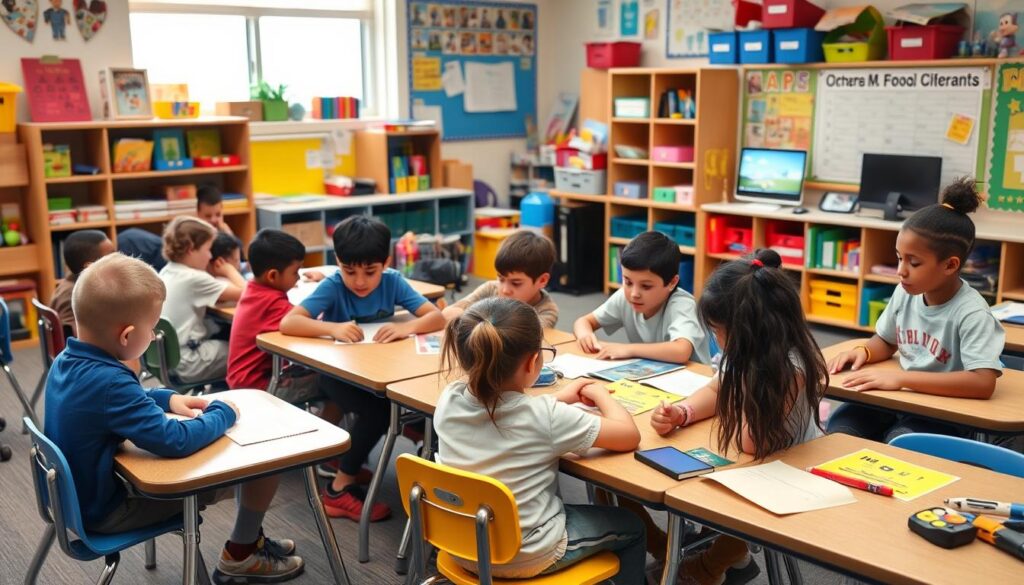Every child learns in their own way. When regular classroom methods don’t work, specially designed instruction helps. It’s about giving students the right tools to learn.
Individualized education plans are more than just paperwork. They offer hope and a chance for students to succeed. Schools can make learning better for everyone with the right accommodations.
In the U.S., about 8% of students get special education. Most of them spend their day in regular classrooms. This shows how important special teaching methods are for everyone to learn well.
Specially designed instruction is all about knowing each student’s strengths and challenges. It’s not just about the usual lessons. It’s about making learning fit each student’s way of learning, so no one is left out.
Teachers who use these methods can help students catch up and feel more confident. They open doors to success that seemed impossible before. Your effort to use these strategies can change a student’s life.
Table of Contents
Understanding Specially Designed Instruction
Education is changing fast, and specially designed instruction is leading the way. Classrooms are getting more diverse, and teachers are using differentiated learning techniques to help each student. This method makes learning personal, helping every student succeed.
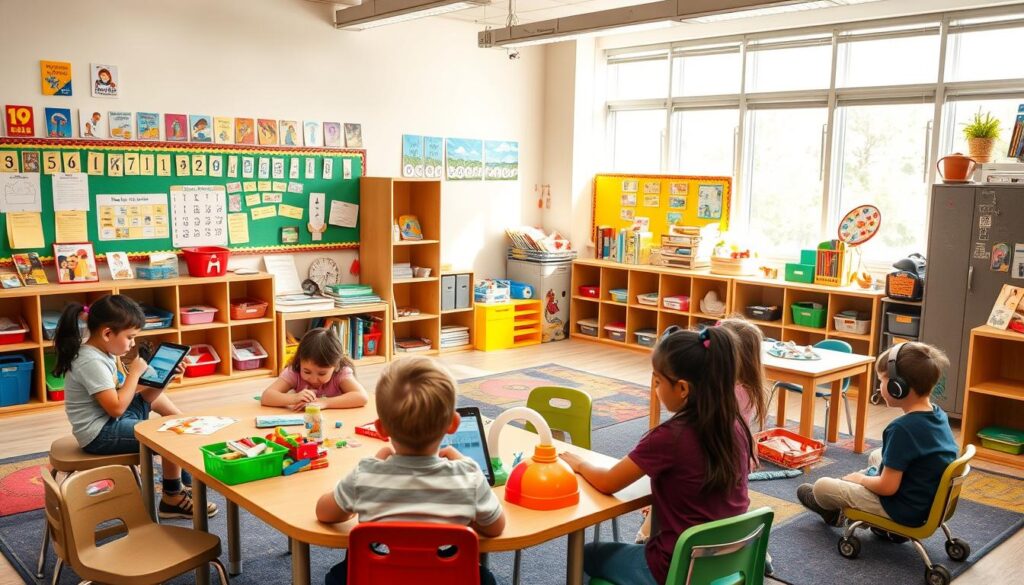
What is Specially Designed Instruction?
Specially designed instruction tailors teaching to fit each student’s needs. It creates personalized learning strategies for specific challenges. This way, students get the support they need to reach their full potential.
“Every student can learn, just not on the same day or in the same way.” – George Evans
Importance in Education
This approach is very important. It helps schools:
- Offer learning paths that fit each student
- Keep students interested and engaged
- Help students with different learning needs
- Boost students’ grades overall
Inclusive education is becoming more popular. It uses strategic plans to meet each student’s learning style. Already, over 45,000 students have seen the benefits of inclusive programs.
Key Principles of Specially Designed Instruction
Special education services are built on key principles. These principles change how students learn. They help teachers create places where everyone can grow and reach their full potential.

Individualization: Crafting Unique Learning Paths
Every student learns differently. Personalized educational strategies make plans just for them. They focus on what each student is good at and what they need to work on.
- Assess individual student capabilities
- Design custom learning objectives
- Create personalized intervention strategies
Flexibility in Educational Approaches
Good special education services are flexible. Teachers need to change how they teach to fit what students need. This makes sure students get the help they need at every step.
| Principle | Key Strategy |
|---|---|
| Adaptive Learning | Modify instructional techniques |
| Dynamic Assessment | Continuous performance evaluation |
| Responsive Intervention | Immediate targeted support |
Evidence-Based Strategies
Using methods backed by research is key. Universal Design for Learning helps teachers make learning spaces for everyone. It makes sure everyone can learn in their own way.
Universal Design for Learning aims to provide multiple means of engagement, representation, and expression for all learners.
Components of Specially Designed Instruction
Creating a great learning experience needs a deep understanding of customized curriculum design and inclusive instructional methods. Each student has unique learning needs. They need personalized educational approaches.
Customized Learning Goals
Setting individual learning goals is a strategic process. It addresses each student’s strengths and challenges. These goals are like roadmaps for success, making sure every learner gets the right support.
- Identify individual student capabilities
- Develop measurable and realistic objectives
- Align goals with student potential
Curriculum Adaptation Strategies
Effective customized curriculum design needs flexible teaching methods. These methods can be changed to fit different learning needs. Teachers must be ready to adjust content, teaching styles, and how they assess students.
| Adaptation Type | Description |
|---|---|
| Content Modification | Adjusting learning materials to match student comprehension levels |
| Instructional Method | Implementing varied teaching strategies to enhance understanding |
| Assessment Approach | Creating alternative evaluation methods that showcase student learning |
Modifications and Accommodations
Using inclusive instructional methods means knowing the difference between modifications and accommodations. These approaches help students with different learning needs access educational content.
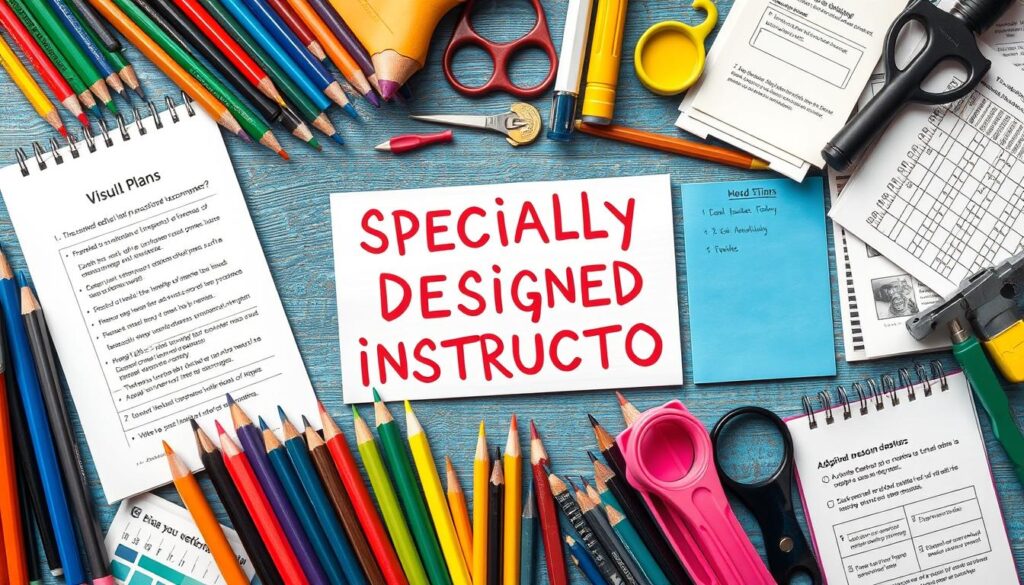
“Education is not one-size-fits-all. It’s about creating pathways for every learner to succeed.” – Special Education Expert
By using these components, teachers can create learning experiences that help students grow and achieve academically.
The Role of Educators in Specially Designed Instruction
Educators are key in specially designed instruction, helping students with unique needs. They turn plans into real learning experiences. This helps students reach their highest potential.

The world of special education is changing. Now, specially designed instruction focuses more on teamwork and student needs.
Training and Professional Development
Teachers need to keep learning to support diverse students. Here are some ways to grow professionally:
- Go to workshops on inclusive teaching
- Get advanced certifications in special education
- Join ongoing training sessions
“Education is not the filling of a pail, but the lighting of a fire.” – William Butler Yeats
Collaborating with Specialists
Good specially designed instruction needs teamwork. Teachers should work well with:
- School psychologists
- Speech therapists
- Occupational therapists
- Parents and family members
But, only 20% of teachers feel ready to use detailed plans well.
Building Relationships with Students
Strong bonds with students are essential. Teachers learn about each student’s strengths and challenges. This helps create learning plans that boost confidence and growth.
Studies show that good communication and building relationships can help students achieve goals by up to 30% in special education.
Assessing Student Needs for Specially Designed Instruction
Understanding what students need is key for good educational help. A thorough assessment gives teachers the insights they need. This helps them tailor learning to fit each student’s needs.
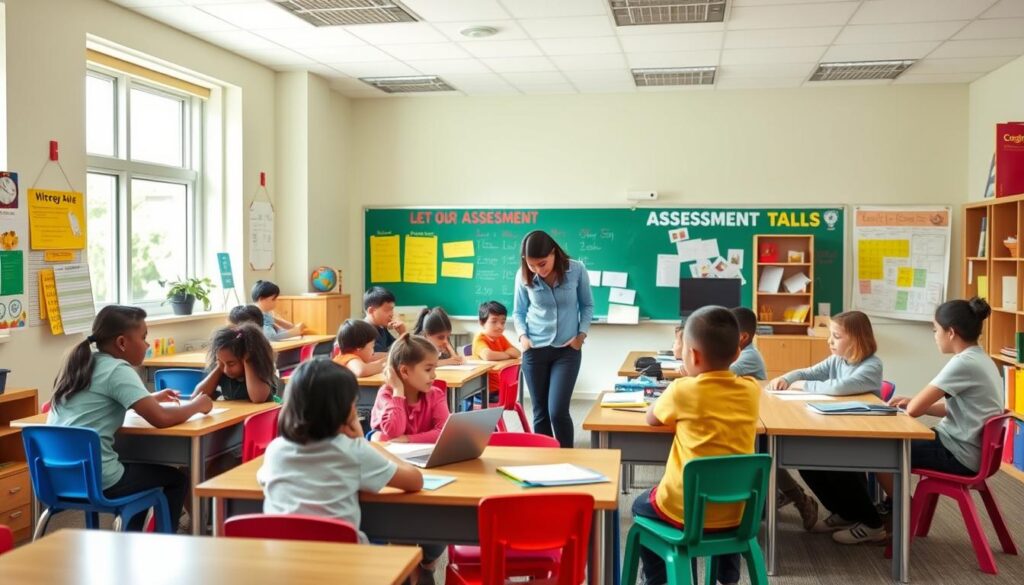
Good assessment uses many strategies. These help teachers see what makes each student unique. It’s more than just tests. It’s about getting a full picture of what students can do.
Tools and Methods for Assessment
Today, we have many tools for assessing students:
- Standardized tests
- Observation protocols
- Portfolio assessments
- Performance-based evaluations
- Student self-assessments
“250 empirical studies indicate that formative assessment can double student learning gains.” – Educational Research Consortium
Continuous Monitoring of Progress
| Assessment Type | Purpose | Frequency |
|---|---|---|
| Formative Assessment | Track ongoing learning progress | Weekly/Bi-weekly |
| Summative Assessment | Evaluate learning outcomes | End of term/semester |
| Alternative Assessment | Measure complex skills | Monthly |
Keeping an eye on how students are doing helps teachers adjust their teaching. Regular checks let teachers tailor their teaching to meet each student’s needs.
The goal is to create an assessment environment that helps students grow. It’s about giving feedback that matters. This way, every student gets the support they need to succeed.
Implementing Specially Designed Instruction Effectively
Creating a successful learning environment needs careful planning and the right strategies. Special education services are key in making classrooms inclusive for all students.
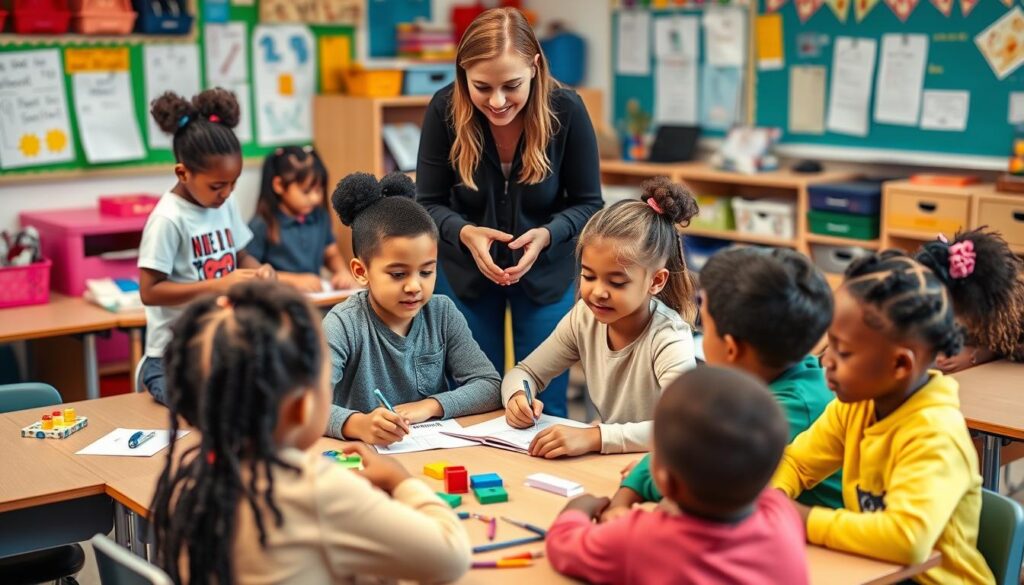
Educators can make their classrooms better by using new methods. These methods help students stay engaged and learn well. Here are some ways to do it:
- Develop clear, individualized learning objectives
- Create flexible learning spaces
- Utilize multiple assessment techniques
- Integrate technology-enhanced learning tools
Creating a Supportive Learning Environment
A supportive classroom understands each student’s unique learning needs. Universal design for learning principles help by offering different ways to learn, engage, and express.
“Every student deserves a learning environment that recognizes their individual potential.” – Educational Research Institute
Engaging Students in the Learning Process
Engaging students means using interactive and personalized learning methods. These make learning meaningful and easy to access. Special education services help teachers create lessons that interest students and encourage them to participate.
| Engagement Strategy | Key Benefits |
|---|---|
| Multi-sensory Learning | Improves information retention |
| Student-centered Activities | Increases motivation and autonomy |
| Technology Integration | Supports diverse learning styles |
By using these methods, teachers can create lively learning spaces. These spaces support every student’s unique educational path.
Using Technology in Specially Designed Instruction
Technology has changed how teachers teach and design lessons. It brings new ways to help students with different learning needs.
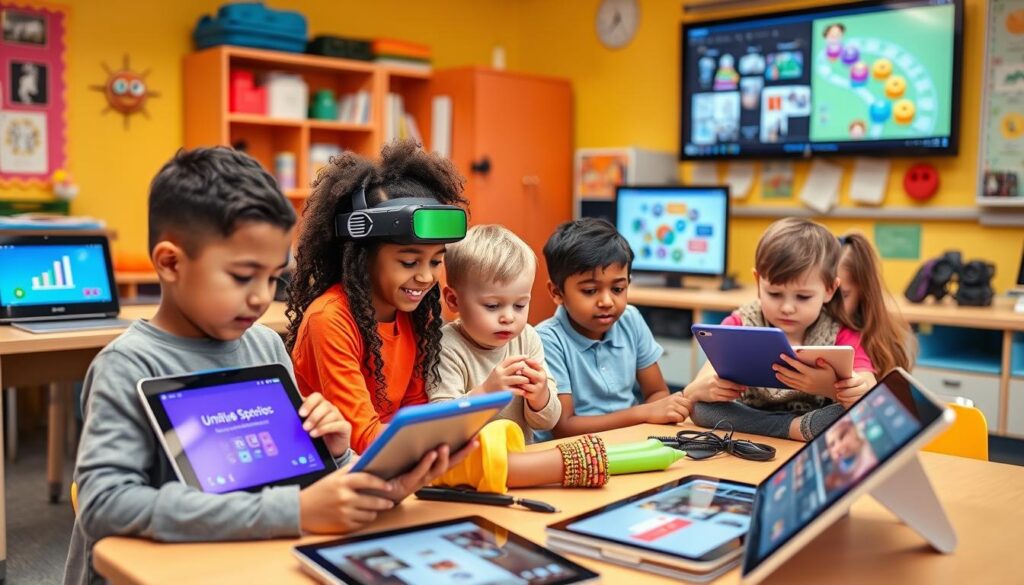
Classrooms are now using new tech to make learning fun and engaging. Students can interact with lessons in many ways.
Assistive Technology Tools
Assistive technology is key for students with special needs. It helps them learn and makes school more inclusive.
- Text-to-speech software
- Specialized input devices
- Screen reading applications
- Adaptive learning platforms
Online Resources and Platforms
Digital platforms help teachers design lessons that fit each student. This makes learning more personal and effective.
| Platform | Key Features | Learning Support |
|---|---|---|
| Wiggleworks | Interactive reading support | Phonics and literacy |
| Write: Out Loud | Text-to-speech writing assistance | Writing skill development |
| Desmos Classroom | Virtual math manipulatives | Mathematical visualization |
“Technology is best when it empowers students to unlock their unique potential.” – Educational Innovation Expert
Studies show that tech can make students more engaged by 50%. Teachers use these tools to make learning fun and tailored to each student.
Challenges in Specially Designed Instruction
Teaching with specially designed instruction can be tough for teachers. These inclusive methods are full of promise but come with their own set of hurdles. Finding the right ways to overcome these challenges is key.
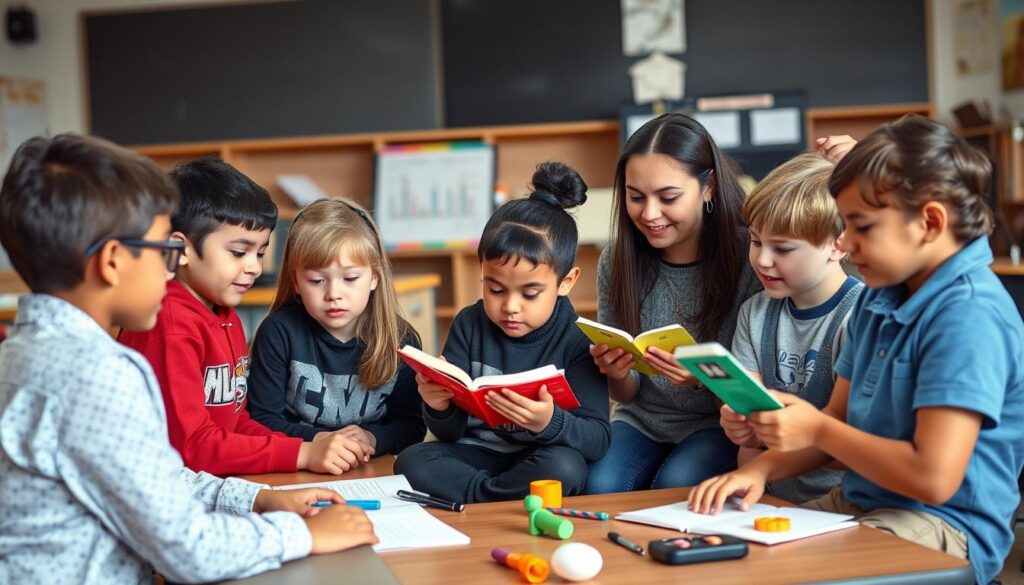
Common Barriers Educators Encounter
Teachers meet many hurdles when they try to create special learning plans. Some of the main issues are:
- Limited classroom resources
- Not enough time for planning for each student
- Difficulty in changing old teaching ways
- Not enough chances for teachers to learn and grow
Strategic Solutions for Effective Implementation
Beating these obstacles needs fresh ideas and teamwork. Specially designed instruction calls for creativity and dedication from teachers.
“The most successful educators view challenges as opportunities for growth and student empowerment.”
Here are some practical ways to tackle these problems:
- Using technology to make lesson planning easier
- Building professional learning groups
- Offering specific training for teachers
- Creating flexible ways to adapt the curriculum
By using these strategies, teachers can turn obstacles into chances for students to learn and grow.
The Impact of Specially Designed Instruction on Student Outcomes
Specially designed instruction changes how students learn by focusing on their unique needs. This approach can greatly improve your child’s educational journey.
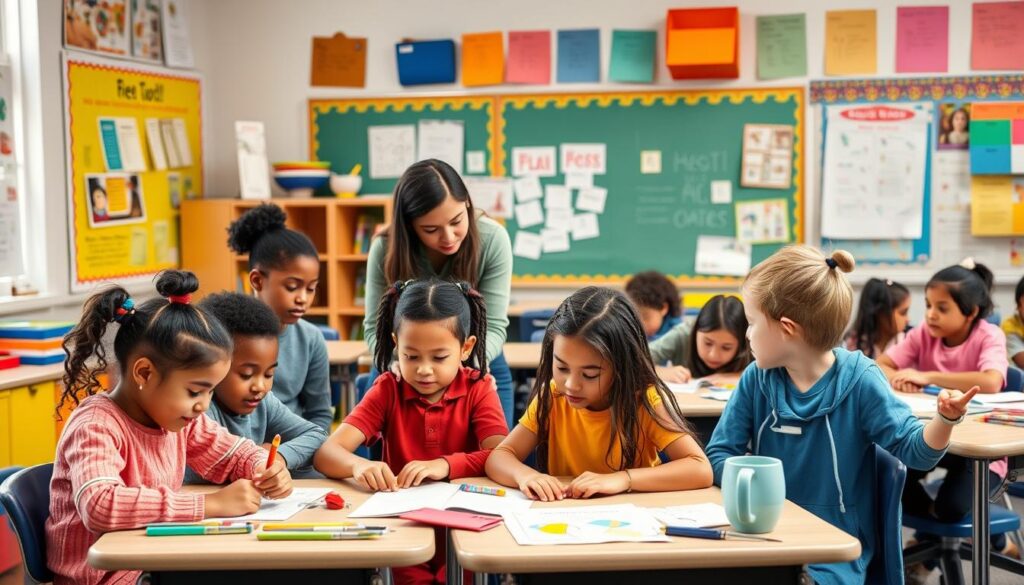
Studies show that personalized learning can lead to big wins for students. An individualized education plan can unlock amazing potential in both academics and social skills.
Academic Achievement Breakthroughs
Students who get specially designed instruction see big gains in their schoolwork. They do better in:
- Thinking and learning skills
- Staying interested in school
- Finishing their work
Social and Emotional Development
Specialized learning also helps students grow in important life skills. They learn to:
- Feel more confident
- Get along better with friends
- Speak up for themselves
“Personalized learning is not about technology, but about understanding each student’s unique learning pathway.” – Education Innovation Expert
| Outcome Category | Improvement Percentage |
|---|---|
| Academic Performance | 65% |
| Social Skills | 55% |
| Emotional Regulation | 50% |
Learning about specialized educational strategies can help students achieve their best. It turns challenges into chances for growth.
Parent and Community Involvement in Specially Designed Instruction
Creating a strong educational environment is more than just teaching in the classroom. Successful schools know that involving parents and the community is key. This helps students grow and learn better.
Engaging families is more than just sending out messages. Schools are changing how they connect with families. They want to build strong relationships that help students do well.
Encouraging Family Engagement
Good ways to involve families include:
- Hosting events that fit with work schedules
- Creating friendly ways to communicate
- Offering materials in many languages
- Running workshops on learning strategies
Building a Supportive Community Network
“Relationships are the lifeblood of activity in a school community.” – Chicago Education Research
Community partnerships are vital for students’ success. Groups like Boys and Girls Clubs, YMCA, and mentorship programs offer extra help.
| Community Resource | Student Support Impact |
|---|---|
| Mentorship Programs | 50% reduction in discipline referrals |
| Family Liaison Services | Improved communication for families with language barriers |
| Community Learning Initiatives | Enhanced academic achievement and school attendance |
By using all-inclusive learning methods and building strong community ties, schools can make supportive places. These places help every student succeed.
Future Trends in Specially Designed Instruction
The world of special education is changing fast. New tech and research are leading the way. Teachers are finding new ways to help all kinds of learners.
Innovations in Teaching Strategies
Artificial intelligence is changing special education. It’s bringing new tools to the classroom. Here’s what’s happening:
- 62% of teachers now use AI for grading and personalized student support
- 73% of education leaders recognize the ethical implications of classroom AI integration
- 85% believe AI can enhance educational practices without losing the human touch
The Role of Research in Education
New studies are giving us important insights. They’re helping us find better ways to teach. Tailored teaching approaches are getting a boost from data.
| AI Technology Impact | Percentage |
|---|---|
| Student Engagement Increase | 40% |
| Learning Outcome Improvement | 30% |
| Administrative Time Saved | 10 hours/week |
The future of special education lies in personalized, technology-enhanced learning experiences that respect individual student needs.
As tech keeps getting better, special education will too. It will offer more support for students with different needs.
Resources for Educators on Specially Designed Instruction
Learning about customized curriculum design is key. It’s important to have access to top-notch resources. CAST (Center for Applied Special Technology) offers great materials based on research. These can change how you teach.
Professional groups are vital for teachers. The Council for Exceptional Children and the International Society for Technology in Education help a lot. They offer chances to grow and learn. Online sites like Coursera and edX have courses on special instruction. They help you improve your teaching and stay updated.
Digital tools have changed how we learn. Sites like Magic School and Brisk Teaching have over 60 AI tools. They make planning and creating assessments easier. Tools like the Lesson Plan Generator and Inquiry Worksheet Generator are great for making lessons for all students.
Keeping up with new teaching methods is crucial. Look into books by experts, join webinars, and go to workshops. This way, you can make learning fun and personal for every student. It helps them succeed.

